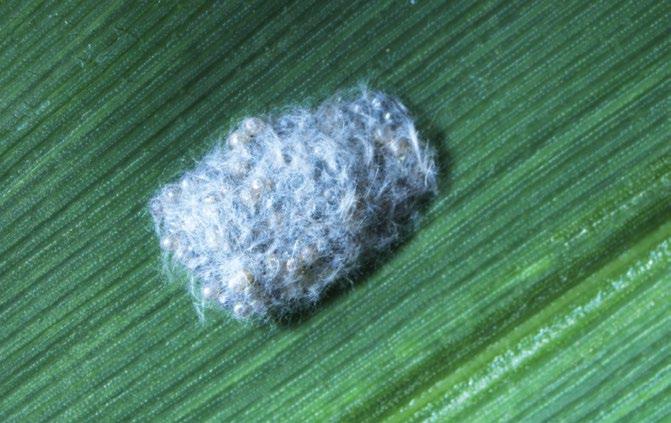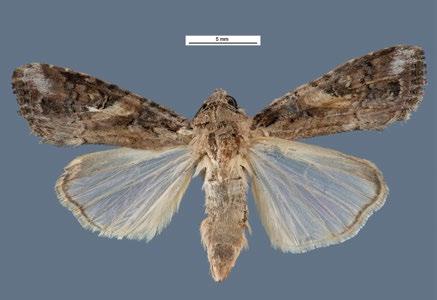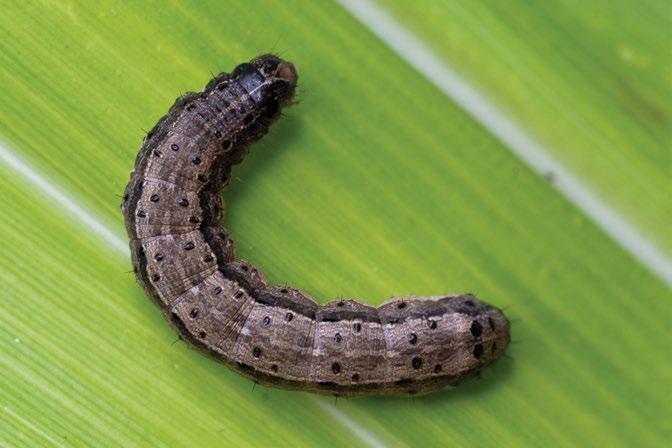
4 minute read
Fall armyworm detected near Gingin
3 THE detection of fall armyworm moths in Gingin follows an earlier detection of fall armyworm in Geraldton.
Advertisement
The pest fall armyworm (Spodoptera frugiperda) was detected near Gingin in November 2020 as part of a surveillance program run by the Department of Primary Industries and Regional Development (DPIRD).
Two moths were recently collected in a pheromone trap north of Gingin. This is the most southerly detection to date in Western Australia since the pest was first confirmed in northern parts of Australia earlier this year. No larvae or feeding damage has been found in the Gingin area, but horticulture, grain and turf grass growers are encouraged to check for larvae in their crops and monitor for unusual levels of damage. The Gingin trap and others further south will continue to be monitored as part of DPIRD’s ongoing surveillance program. Suspected fall armyworm should be reported to DPIRD to assist with surveillance and potential management options.
WA activity
DPIRD has deployed more than 50 pheromone (lure) traps throughout northern WA, including Kununurra, Broome, the Pilbara, Carnarvon, and Geraldton. These complement existing traps in Kununurra, which have operated since October 2019. The DPIRD Grainbelt trapping program of approximately 70 traps has ceased, with crops drying out in most areas and harvest underway. Select sites remain and will be monitored over summer. Traps have also been placed in horticultural regions in southern WA. The detection of fall armyworm moths in Gingin follows an earlier detection of fall armyworm in Geraldton. Thus far, no established populations of fall armyworm have been found south of Carnarvon.
3 FALL armyworm eggs are white to pale-yellow coloured and laid on leaves in clusters of 50 to 200 eggs, covered in layers of hair or scales.

3 FALL army neonates that have just emerged from the eggs are light coloured with a darker head.


These surveillance trapping networks Samples of fall armyworm larvae from assist in providing early warning advice Kununurra and Broome were sent by to industry about the presence of fall DPIRD to the Insecticide Resistance armyworm as the pest potentially Unit at New South Wales Department migrates further south. of Primary Industries (NSW DPI) for DPIRD continues to liaise with the Australian Government, state and territory governments Suspected fall analysis. Larvae were tested for the presence of genes that are linked to resistance to Group 1 insecticides. and industry groups, which are collaborating to assist in preparing for and armyworm should be reported to DPIRD. Genes that may confer resistance to the Group 1 insecticides were found in minimising the impact of all of the small sample of fall armyworm as it becomes larvae tested. more broadly established. Further testing is necessary to Pesticide resistance genes in determine the distribution of the genes WA’s fall armyworm population Pesticide resistance genes have been detected in WA’s fall armyworm population. in other locations across WA, and validate and expand on the preliminary research results by testing for resistance genes to other pesticides.

3 MALE fall armyworm moth.

FIGURE 1. THE FALL ARMYWORM LIFE CYCLE HAS FOUR DISTINCT PHASES: EGGS, LARVAE, PUPA, AND MOTH.
Light bands on the sides with a dark band in between
Pale dorsal line
Inverted ‘Y’ marking on the head area
Four large spots in a square arrangement on the second to last segment

Four smaller spots in a trapeze arrangement on other segments
FIGURE 2. KEY FEATURES ON FALL ARMYWORM CAN BE USED FOR IDENTIFICATION.
It is likely that fall armyworm entered Australia carrying the genes and that the traits will spread as fall armyworm migrates throughout the State. There is also the possibility that new resistance genes will develop in Australia. Continual monitoring for resistance mutations and careful evaluation of pesticide efficacy over time will be important in the ongoing management of this pest. Growers are encouraged to judiciously select any pesticides to be used, and ensure insecticides are rotated to reduce selection pressure.
Chemical permits
The Australian Pesticide and Veterinary Medicine Authority (APVMA) has issued a number of permits for the use of certain chemicals for the control of fall armyworm. More information is available from the APVMA Online Portal at https://portal. apvma.gov.au/permits. Search for ‘fall armyworm’. The permits should be read in conjunction with the relevant product label for information on withholding periods and other critical comments.
Biosecurity and reporting
Horticultural, turf grass, irrigated crop and pasture growers are encouraged to regularly monitor their crops for the presence of fall armyworm larvae over the summer period. Fall armyworm appears similar to other caterpillar pests. Care should be taken to carefully identify the insects in crops.
MORE INFORMATION
Report suspected fall armyworm damage to DPIRD’s Pest and Disease Information Service(PaDIS) by calling (08) 9368 3080 or email padis@dpird.wa.gov.au, or use the MyPestGuide Reporter app. More information is available on the DPIRD website at agric.wa.gov.au. Search for ‘fall armyworm in Western Australia’.
General enquiries or suspect reports can be made to PaDIS by calling (08) 9368 3080 or email padis@dpird.wa.gov.au. WA industry enquiries can be directed to Helen Spafford, Senior Research Scientist










